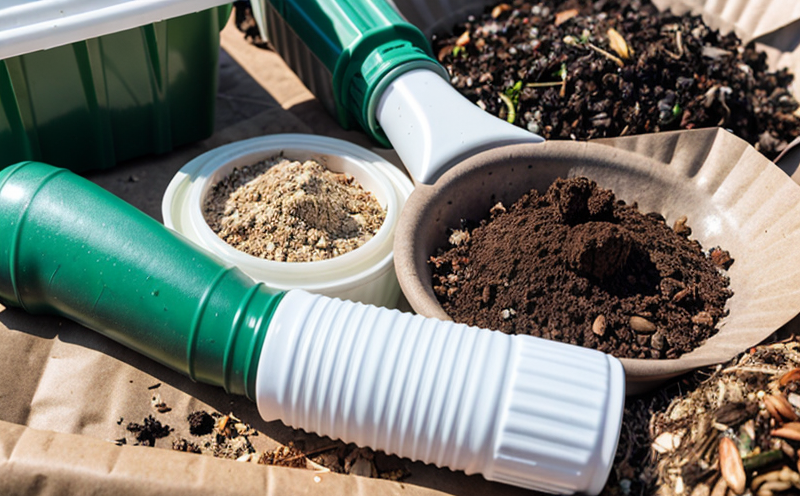ASTM D7834 Carbon Sequestration Potential of Organic Waste
The ASTM D7834 test method is designed to evaluate the carbon sequestration potential of organic waste materials. This service is particularly relevant for industries focused on sustainable waste management, composting, and environmental compliance. By quantifying the amount of carbon that can be captured by organic waste during decomposition, this testing ensures that waste products are managed in a manner that maximizes their environmental benefits.
The ASTM D7834 test is based on internationally recognized standards for ensuring accurate and reliable results. It involves determining the mass loss and gas production from the organic waste over time under controlled conditions. This process helps identify which types of compostable materials can effectively sequester carbon, thereby contributing to climate change mitigation efforts.
The importance of this testing cannot be overstated, especially in today’s era where sustainability is paramount. Understanding how different types of organic waste behave during decomposition allows for better decision-making regarding waste management practices and product development. For instance, knowing which materials have high carbon sequestration potential can guide manufacturers towards creating products that not only meet regulatory requirements but also offer significant environmental benefits.
One key aspect of ASTM D7834 is its focus on quantifying the amount of carbon captured by organic waste during decomposition. This provides valuable insights into which materials are most effective at sequestering carbon, thus helping to reduce greenhouse gas emissions associated with landfills and other disposal methods. Additionally, understanding these properties enables more informed choices about where and how certain wastes should be disposed.
Another crucial element of ASTM D7834 is the ability to predict long-term effects of different composting processes on carbon sequestration rates. This knowledge can help optimize industrial-scale composting operations by selecting appropriate feedstocks that will maximize carbon storage over time. Moreover, it allows for better planning and implementation of green initiatives aimed at reducing carbon footprints.
Furthermore, this testing serves as an essential tool in meeting regulatory requirements related to organic waste management. Many regions have specific regulations governing how certain types of organic materials must be handled post-consumer use. Knowing the exact amount of carbon that can be captured by these wastes helps ensure compliance with local laws and regulations while also promoting responsible waste disposal practices.
It is worth noting that ASTM D7834 does not only apply to municipal solid waste but extends its application to various other sectors including agricultural residues, forestry products, and bio-based plastics. This broad applicability makes it an indispensable tool for researchers, engineers, and policymakers working across multiple industries.
In summary, the ASTM D7834 test method plays a critical role in advancing our understanding of organic waste management practices by quantifying carbon sequestration potential. It provides valuable information that supports sustainable development goals while ensuring compliance with relevant regulations. By leveraging this knowledge, stakeholders can make more informed decisions about waste disposal methods and product design.
Scope and Methodology
The scope of ASTM D7834 encompasses the evaluation of carbon sequestration potential in organic wastes through standardized laboratory procedures. This includes measuring the amount of carbon dioxide (CO2) produced during decomposition, as well as assessing changes in mass over time.
- Sample Preparation: Samples are typically prepared according to specified weight ranges and moisture content levels to ensure consistency across samples.
- Incubation Conditions: Testing is conducted under controlled temperature, humidity, and aeration conditions to mimic real-world composting environments as closely as possible.
- Data Collection: Continuous monitoring of gas production (CO2) and mass changes over defined periods allows for accurate quantification of carbon sequestration capabilities.
The methodology ensures that all tests are conducted consistently, allowing for meaningful comparisons between different waste materials. Compliance with ASTM D7834 provides confidence in the reliability and accuracy of results, making it an ideal choice for both academic research and industrial applications.
International Acceptance and Recognition
The ASTM D7834 test method has gained widespread acceptance globally due to its rigorous standards and consistent methodology. It is recognized by numerous organizations involved in environmental protection, waste management, and sustainable development initiatives.
Many countries have adopted ASTM D7834 as part of their regulatory frameworks for organic waste management. For example, the European Union's Waste Framework Directive encourages member states to use such standardized testing methods when evaluating the environmental impact of different waste streams.
In addition to national regulations, international bodies like ISO and the United Nations Environment Programme (UNEP) have endorsed ASTM D7834 as a best practice for assessing carbon sequestration in organic wastes. This recognition underscores its importance within the global community's efforts towards climate change mitigation.
The widespread adoption of ASTM D7834 also reflects its practical utility across various sectors, including agriculture, forestry, and bioplastics manufacturing. By providing a standardized approach to measuring carbon sequestration potential, this test method facilitates collaboration between academia, industry, and government agencies worldwide.
Use Cases and Application Examples
- Agricultural Residues: Testing agricultural residues such as corn stover or wheat straw can help determine their suitability for use in composting processes that enhance soil health.
- Forestry Products: Evaluating wood chips or sawdust from forest operations provides insight into how these materials contribute to carbon sequestration when incorporated into compost systems.
- Bio-Based Plastics: Assessing the performance of biodegradable plastics under ASTM D7834 helps identify those with superior carbon-sequestering properties, promoting their use in sustainable packaging solutions.
In all these cases, ASTM D7834 plays a crucial role by providing quantitative data that supports informed decision-making about waste management strategies and product development. The results generated through this testing can significantly influence policy decisions at both local and international levels.





